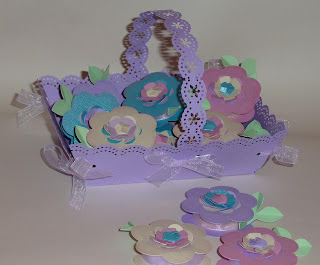 | ||
| Mexican-style banners made with Tonic paper punches (and a die). |
The buntings on my thank you cards are made with Tonic Studios products. For the straight lattice design, I used Simplicity Pattern Punch Doily Border 967e. The flags with the gently curving corner were made using the Doily Square Die (item 226e). The flower shapes were cut out with Petal Pairs Petites (I used Petites 1 no 892e, Petites 2 no 893e, and Petites 3 no 894e). It is important to use the Petal Pairs Petites because their smaller size makes a flag about the right size for a greetings card.
Remember to vary the colours, size, and styles of your flags. Note that the pennant-style flags have the punched border at the top. The teeny-tiny flags do not have a flower shape punched out. If you make a card with rows of buntings in graduated sizes, largest flags at the top to smallest on the bottom, then your card will have a perspective effect - like looking down a street festooned with bunting.
I used ordinary coloured paper from a pad for the bunting, and craft thread for stringing. To make each flag, punch the border first. Next, position the paper punch flower and cut it out. Cut the flag out around the punched shapes to engineer the position of the border and motif.
You can trim the punched borders in various configurations. If you are working with the doily, use it on point (love those handkerchief points!). I used a 1/16" circle handpunch to pierce the stringing holes at either side of each flag. Alternatively, you can pierce the holes with a needle - put a kneaded eraser underneath to receive the point.
For the card blanks, I computer-printed the greeting onto 160gsm copier paper. The patterned paper is October Afternoon Modern Homemaker, which isn't new - but is still available. I positioned a bit of punched border underneath the patterned paper strip as an accent mat and also glued punch-outs from the Petites as bullet-point-style embellishments next to the greeting.
You can use brads to mount the bunting on the card front - or you can just pierce holes and thread the craft thread through. For a side-opening card, you need one pierced hole on the opening side (wrap the thread around the edge) and two on the fold side (one hole placed on the fold).
You can also make bigger, more elaborate versions of the buntings and use them as full-size festive decoratations.
If you want to learn more about papel picado, there's a delightful book by Kathleen Trenchard called Mexican Papercutting (Lark Books, 1999). It's out of print, but you can still get hold of it on Amazon. Here it is:
Enjoy punching out your festive buntings!
Now, I know that many craft-y people are already very busy with festive preparation of another kind. Please stay tuned, because I am planning a post on paper snowflakes made with the new Tonic Dies:























































